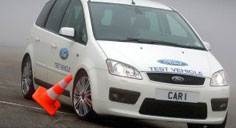We're committed to having the freshest lineup of new cars, crossovers, trucks and SUVs in the industry.
To help shave more than a year off the time it takes to bring new vehicles from the drawing board to production, we've completed a $43 million transformation of our historic proving ground into the world-class Dearborn Development Center.

World-Class Facility
We transformed the 81-year-old Dearborn Proving Ground from a single-purpose facility - used in the past for fuel economy measurement and routine testing - into one of the most advanced automotive testing facilities in the world.
At the testing facility, vehicles under development will be driven more than a million miles a year on flooded asphalt, rutted roads, and on high-speed, high-banked curves. The extreme conditions are part of Ford's rigorous testing requirements for quality.
Special Test Surfaces
The facility also includes a new 43-acre vehicle dynamics area, 12-acre asphalt wet pad, 2.5-mile steering and handling course, and 4,000-foot straightaway. Engineers use the testing areas to develop and fine-tune a vehicle's driving characteristics and for safety validation.
The facility's "World Roads" section includes varying types of extreme road conditions found anywhere from Belgium to California to Michigan. The roads allow engineers to test early vehicle prototypes in a real-world environment in manner that is safe, controlled and secure.
Global Standards
The new Dearborn facility benefits from our expansive global network of product design, engineering and testing centers. The steering and handling course is nearly identical to Ford's test track in Belgium. Now engineers on two continents can evaluate vehicles in a consistent setting.
The new test facility was designed with quality and safety leadership in mind. Engineers use the track to improve quality, wind noise, vibrations and powertrain performance.
Advanced Safety
The Dearborn Development Center is adjacent to Ford's recently opened Safety Innovation Center and crash barrier building. Both are part of a previously announced $65 million investment in advanced vehicle testing technology.
The safety facility joins a multitude of safety-testing assets around the globe, giving us the ability to conduct some of the most comprehensive occupant protection crash simulation tests in the industry.
Environmental Upgrades
The facility's improvements allowed the reopening of an oxbow - or bend in the river - on the nearby Rouge River. The oxbow was closed off in 1972 as part of a project to pave the river to control flooding and pollution.
Reopening the oxbow restores natural wetlands for wildlife and creates a place for recreational use of the river. Work is under way to connect both ends of the oxbow to the Rouge River.
In addition, the facility was built with recycled crushed concrete from a local road construction project. The move kept 500,000 tons of concrete from local landfills.
The site's new Product Review Center also features environmentally responsible design and construction and is awaiting certification by the U.S. Green Building Council.
A Storied History
The test track site opened in 1925 as a commercial airport with flights between Detroit and Chicago. In 1938, test tracks were laid around the airport runways, and Ford's Dearborn Proving Ground was born.
In 1947, The Ford Air Transportation Service relocated to Detroit Metropolitan airport, and the 365-acre site became a full-time automotive test facility. Today, the experimental vehicle building and experimental engine building - originally used as airplane hangars - are the only structures remaining from the airport.
Through the years, Dearborn Proving Ground led the industry in advanced vehicle testing, resulting in such iconic products as the 1949 Ford and 1964 Ford Mustang.

